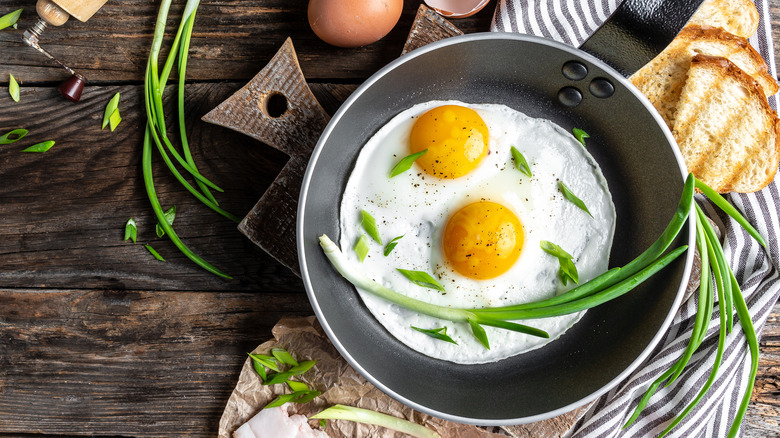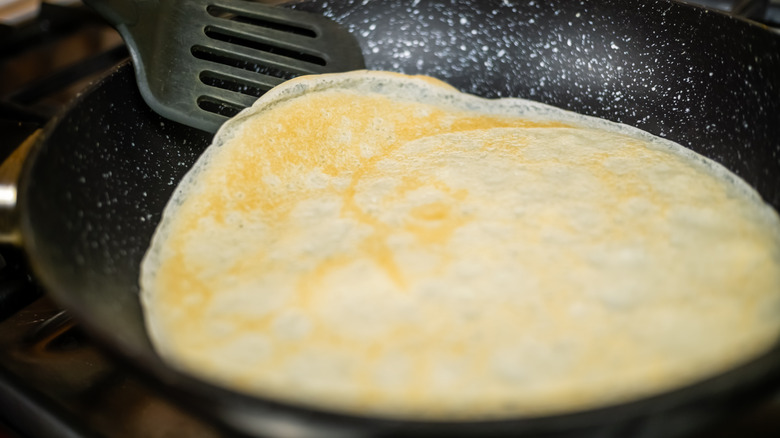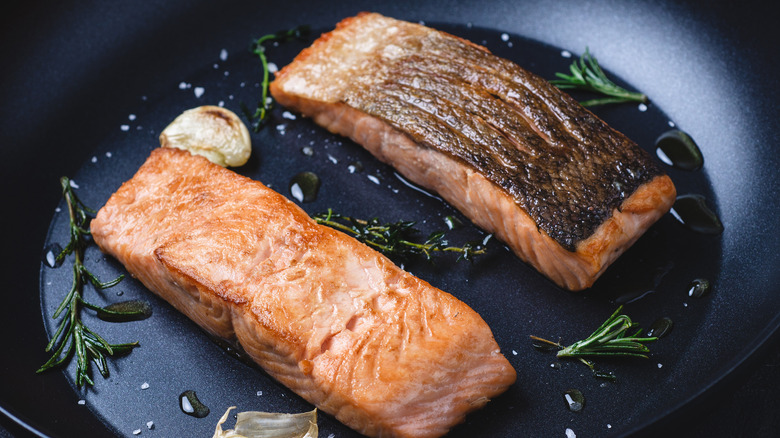You Need To Think Twice Before Using Cooking Spray On Nonstick Pans
A nonstick pan is an essential cooking tool for any kitchen. While it can be easy to take this common household pan for granted, its slick surface can be a game-changer for a variety of lower-heat cooking techniques, such as flawlessly flipping a French omelet or making fluffy buttermilk pancakes. The pan provides for seamless cooking, preventing food from sticking to the bottom of the pan and allowing for simpler and quicker cleanup without the fierce scrubbing.
As with any good kitchen equipment, it's important to know how to care for nonstick pans to preserve their quality and functionality. Perhaps one of the most routine misuses of nonstick pans is using cooking spray on the surface. While it may seem harmless (and helpful) to use an oil spray that frequently has "nonstick" in the name, this is a habit you want to avoid when it comes to nonstick pans.
This is because lecithin, an ingredient added to many cooking sprays to help hold the oil in suspension as it's dispensed from the container, leaves a residue that damages the layer of coating that makes a pan nonstick. You may have noticed this as an insidiously sticky coating that won't come off the bottom of the pan, no matter how much you scrub (which further degrades the pan). Additionally, the thin layer in which cooking spray is applied to the pan burns easily, which also harms nonstick pans' coating.
What makes a pan nonstick?
Due to its tendency to burn and leave damaging sticky residue, you'll want to avoid using cooking spray to maintain the quality of a pan's nonstick cook surface. What makes nonstick pans so useful and convenient is the layer (or layers) of low friction, heat-resistant coating that makes cooking delicate dishes, such as eggs or crepes, a breeze. Nonstick pans are typically made of metal (often aluminum or stainless steel) and coated with Teflon (the chemical polytetrafluoroethylene, or PTFE), or with a silicone coating for ceramic nonstick pans.
Nonstick cookware is best used at low or medium heat cooking to preserve the coating. While Teflon coating can be heat-resistant at temperatures up to 400 degrees Fahrenheit and ceramic nonstick pans can withstand heats up to 800 degrees, the pans' nonstick action works best under lower temperature cooking.
Cooking over lower heat also extends the life of the pan and protects the coating so it can be used week after week for your cooking needs.
How to care for nonstick pans
A quality nonstick pan can last for up to five years, if treated well. Save the cooking spray for other surfaces, such as baking trays, and refrain from spraying the stuff on nonstick pans.
To protect nonstick pans' coated finish, be mindful and use gentler temperature and handling methods. Always use low to medium heat when cooking with nonstick pans. Instead of using cooking spray, pour in a tablespoon or two of vegetable oil, or add butter, into the pan to provide an extra-slick surface without the sticky residue. Applying fat to the pan in this way creates a thicker layer of cooking fat that won't burn as easily as the thin mist of the spray. You'll also want to add cooking fat directly to the pan before you turn on the heat, and avoid preheating a dry pan and exposing the nonstick coating to unnecessarily high heat.
Use a wooden spoon or silicone spatula to prevent scratching the pan. Once you've finished flipping and plating dishes, let the pan cool completely before washing it. Take the extra time to hand-wash your pan, and use soft cleaning materials as opposed to overly abrasive soaps or sponges.


